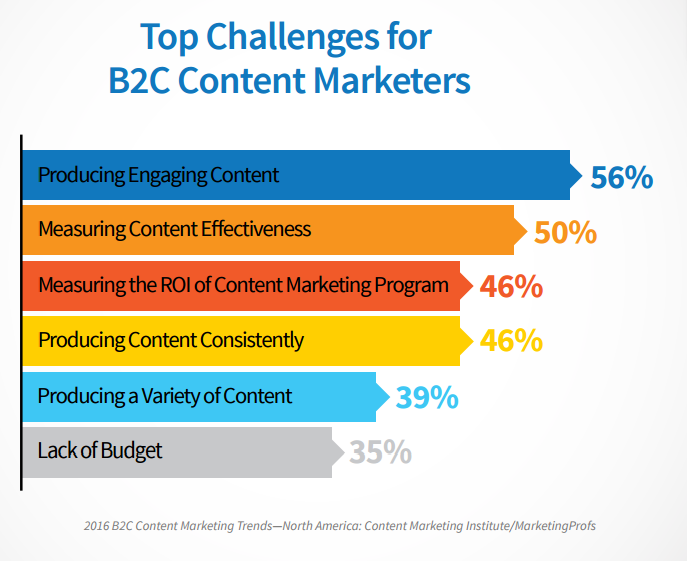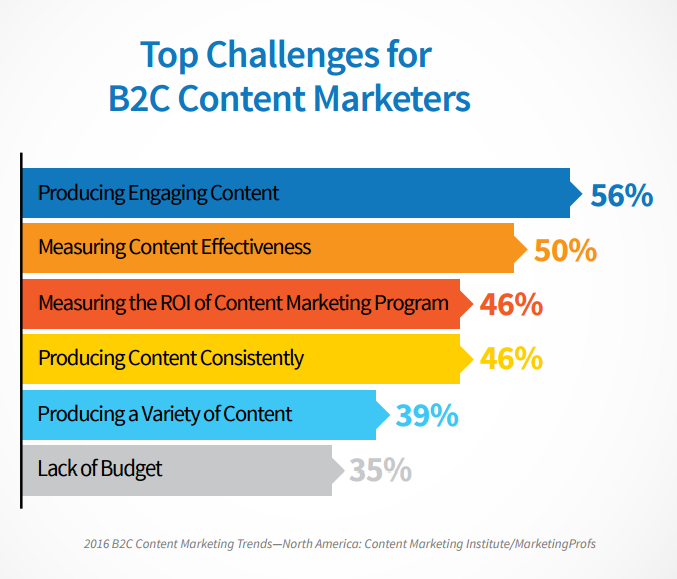
by Fronetics | Jan 12, 2017 | Blog, Content Marketing, Marketing, Social Media, Strategy
Competitive benchmarking should be part of your data-driven marketing strategy.
In August 2016, Elaine Thompson claimed the mantle of world’s fastest woman, and Michael Phelps became the most decorated Olympian of all time. Thompson and Phelps achieved these incredible feats by continuously pushing themselves to do better. To do this, they not only tracked and measured their personal performance, but they also tracked the performance of their peers and of their competitors. Together, this data gave Thompson and Phelps the knowledge and drive needed to improve their own performance.
When it comes to measuring marketing performance, most marketers look inward, focusing on key performance indictors (KPIs) such as website traffic, open rates, social engagement metrics, and conversion rates. While these inward facing KPIs are important, it is also important to look at what is happening outside your organization and to benchmark your marketing performance against peers and competitors. This will give you the knowledge and drive you need to improve your performance and chance of success. It can help you to identify threats and strategic opportunities.
WHO
When adding competitive benchmarking to your marketing strategy the first step is to determine who to benchmark against. I recommend not just benchmarking against direct competitors, but to also benchmark against industry leaders, and against a company or two that you think is excelling (this company does not need to be in your industry). By taking this more global view, you can gain ideas and intelligence from industry leaders and from the creative and strategic minds of top performers. A word of caution – be strategic and keep the number of companies to a reasonable number.
WHAT
While you should determine the KPIs to track and measure based on your business and marketing goals, here are some to consider:
- Traffic by channel
- Visits by source
- Bounce rate
- Keywords
- PPC activity and spending
- Social engagement
- Social reach
- Posting times
- Top performing content
- Meta description (company positioning)
As with your inward facing KPIs, action is key. Use the data you gather to inform your strategy.
You might also like:

by Fronetics | Dec 22, 2016 | Blog, Content Marketing, Marketing
At Fronetics, we work with companies in the logistics and supply chain industries to create and execute digital and content marketing strategies. Understanding the sales processes of our clients, working closely with sales, and developing effective lead generation strategies is at the heart of what we do.
Here are our 5 most read sales and lead generation posts of 2016.
Sarah Collins, an intern Fronetics and a student at James Madison University, College of Business studying Marketing, writes how aligning sales and marketing helps companies achieve 20% higher annual growth rates and improves deal closings by 67%. Read more.
Leads are only valuable if they convert into customers. So, generating quality leads is only half the battle. You need a sales team that knows how to resuscitate a lead, nurture it, and, ultimately, turn it into a customer. Read more.
B2B sales must recognize and accommodate buyers at various levels of self-sufficiency in the purchasing process. Read more.
The most efficient lead-generation strategy includes a way to capture potential customers’ information. Read more.
If you feel your marketing campaign falls short in generating quality leads, you are not alone. Typically, one in 10 marketing professionals questions the effectiveness of their lead generation methods. While you may have some of the components of a strong campaign in place, it is possible that you are leaving out a very important ingredient for success: a call to action (CTA). Read more.


by Fronetics | Dec 14, 2016 | Blog, Content Marketing, Logistics, Marketing, Supply Chain

In 2016 88% of B2B marketers reported using content marketing to market their business, up by almost to 3% over 2015. B2B markets are increasingly using content marketing because they recognize that it an effective tool to increase brand awareness, and to attract, engage, and convert new customers. With 51% of B2B buyers relying on content research and to make B2B purchasing decisions than they did a year ago, businesses who aren’t using content marketing are missing out on opportunities that ultimately impact their bottom line.
Fronetics is a boutique marketing firm focused on the supply chain and logistics industries. We work with companies to create and execute data driven marketing strategies with the objectives of increasing brand awareness, positioning companies as thought leaders, driving meaningful engagement with prospects and customers, and helping companies to grow their business.
Every day we see the impact content marketing has on companies within the supply chain and logistics industries. One client, for example, has realized a 30% net increase in new customers since the implementation of their content marketing strategy.
We have pulled together our top 10 content marketing posts of 2016. We hope these will help you to develop and/or strengthen your content marketing strategy in the coming year.
Top 10 Content Marketing Posts of 2016
This is a guest post by Jennifer Cortez, Director, Marketing Communications, Transplace. Cortez discusses how Transplace, a North American non-asset-based provider offering manufacturers, retailers, chemical and consumer packaged goods companies the optimal blend of logistics technology and transportation management services, has used content marketing and she offers up 3 tips for creating valuable and compelling content. Read more.
We’ve pulled together 19 content marketing trends that companies within the logistics and supply chain industries should take note of. Read more.
3. How to Overcome Your Biggest Content Marketing Challenge
2016 reports produced by Content Marketing Institute and MarketingProfs, and sponsored by Brightcove outline the biggest challenges B2B and B2C companies face when implementing content marketing strategies. We discuss how you can overcome these strategies and be successful. Read more.
TotalTrax Inc., a provider of real-time vehicle, driver, and inventory tracking technologies for manufacturing and warehouse operations, worked with Fronetics to leverage content marketing to increase web traffic, generate high-quality leads, and, ultimately, grow business. Read more.
10 content marketing strategy statistics that underscore the importance of developing a clear content marketing strategy to advance your business goals. Read more.
Outsourcing content marketing can cost a fraction of what dedicating in-house resources would — and you’ll get better results. Read more.
Content marketing is one of the most effective ways to increase brand awareness, broaden your customer base, and grow your business. Yet of the 88% of B2B marketers using content marketing, only 30% feel their efforts are successful. Why do so many organizations feel they are failing? Simply put, they do not have a documented content marketing strategy in place. Read more.
Speak your boss’ language with metrics, statistics, and facts that articulate content marketing’s impact on customer acquisition and sales. Read more.
What is influencer marketing and how can supply chain companies use it to win over customers? Read more.
A blog post not only stays around longer than a print ad, it can better engage potential customers. Read more.


by Fronetics | May 17, 2016 | Blog, Content Marketing, Marketing, Strategy
Producing engaging content is the number one challenge for content marketers.
Is content marketing working well for your business? If not, you are not alone. Though it is one of the most effective ways to grow your business, content marketing has been challenging B2B and B2C organizations since its inception.
You may think it should be simple: Write, post, get more customers. But content marketing is much more complex, demanding more time, thought, and careful strategy than churning out a few blog posts. First and foremost, what you produce must engage readers. This is, however, the biggest content marketing challenge facing both B2B and B2C marketers.
2016 reports produced by Content Marketing Institute and MarketingProfs, and sponsored by Brightcove, found that the number one challenge for B2B and B2C marketers is producing engaging content.


Dull content and the domino effect
Unfortunately, if you lack engaging content, it works like a domino, knocking down all your other marketing efforts.
For one, it is much easier to gain the support of the C-suite, and be granted a reasonable budget, for your content marketing plan if you can show that your strategy is attracting more customers, helping with conversions, and driving sales. But if your content is not producing results, you won’t get the support and resources you need to produce the content, which, in turn, fuels results. It is a vicious cycle.
That being said, lack of engaging, quality content may be indicative of other challenges you may be facing, like the resources to produce content.
Creating engaging content
There are a few basics you must address if you are going to produce engaging content:
- Research your customer demographic. You must know who your audience is, what they want to know, how they want to learn it, and where to find them. Use web analytics to learn how your audience interacts with your website, what kinds of posts and emails they are reading, and where improvements can be made.
- Do your due diligence and learn how to reach those potential customers with topical information they want and will read. This means conducting a solid analysis of trends in your industry and producing content that offers expert information on these subjects or answers pressing questions potential customers may have about them. You, thus, will establish your organization as a trusted voice for your industry. This leads to dialogue with prospects and customers that want to learn more from you about industry news — or, even better, who are interested in your products or services.
- Research your distribution channels. This can affect not only what you post, but where and when you post it. Know your target’s social media habits, when they read emails, and what they are looking for. Research your competition and learn which channels they focus their attention on and why. Read the latest industry publications and influential blogs to uncover what topics work to engage their readers. Look for trends and answer to them.
- Look at SEO evaluations and site audits to help identify new middle- and bottom-of-the-funnel opportunities for content.
- Tell a story.
If creating engaging content has proven to be challenging for your business, consider outsourcing your content creation, or your marketing program all together. According to Social Media Today, lack of marketing staff can make it difficult for organizations to produce enough content to keep up with their competition.
Quality research and consistent creation of engaging, relevant content is time-consuming and requires keen writing skills. Promoting your posts on social media also takes time and requires consistent effort. Some of the most successful organizations put this task in the hands of an expert that can create and leverage content to provide the greatest impact to your brand, lead generation, and new customer conversion rate.
Related posts:


by Fronetics | May 16, 2016 | Blog, Content Marketing, Logistics, Marketing, Supply Chain

Dear companies in the logistics and supply chain industries,
You have leveraged technology and innovation so that two-day shipping is becoming more of the norm rather than the exception. You have developed processes and standards for IT Asset Disposal (ITAD), which mitigate asset recovery management and increase data security. You have leveraged 3-D printing — disrupting the status quo.
Cathy Morris, senior vice president and chief strategy officer for Arrow Electronics, Inc., puts it well: “Products can be made, money can be invested, ideas can be brought to fruition, but without the supply chain everything stops. The supply chain provides routes to market; everything hinges on an effective supply chain.”
In short, logistics and supply chain — you are pretty damn awesome.
Given your awesomeness, I wonder why marketing firms have taken to courting your business by promoting that they do “content marketing for boring industries.” You are not boring (in the least). Why would you choose to partner with someone that finds you boring?
Content marketing can be an effective tool for your business. When aligned with your business objectives, content marketing can:
- Build brand awareness
- Position your company as a thought leader within the industry
- Increase engagement with customers, partners, and stakeholders
- Educate and inform customers, partners, and stakeholders
- Build trust
- Allow you to manage your reputation
- Generate leads
Given the impact a successful content marketing strategy can have on your business, doesn’t it just make sense to find a marketing firm that recognizes the value of your industry and of your company; a firm that recognizes your awesomeness?
I lead the digital and content marketing arm of Fronetics Strategic Advisors. Our firm focuses on companies within the logistics and supply chain industries. Why do we do this? We do this because we have deep expertise in these industries, and because we believe in these industries. We stay up to date on industry trends. Phrases like: “Can you believe the capabilities of company x’s new forklifts?” and “Wow, the reverse logistics implications of that are going to be significant,” are daily conversations for us.
I am not saying that you need to choose our firm as your marketing firm, but, please, choose a firm that believes in you. When choosing an outsource partner, evaluate not just the firm’s marketing capabilities, but also their knowledge of your industry.
You do incredible work. Find a partner who recognizes this, not one who finds you boring.









